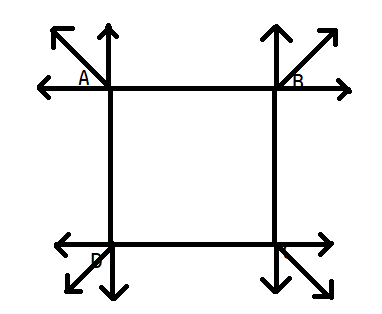
Four charges of \[6\times {{10}^{-8}}C\] coulomb each are placed at the corner of a square whose sides are 3 cm each. calculate the resultant force on each charger and show in direction and a diagram drawn not to be scale
Answer
566.4k+ views
Hint: We will calculate only for one of the charges because the magnitude of force will be equal for all the cases for all the four charges. We had represented them in the figure. Since force is a vector quantity, we add it using either triangle law of vector addition or the parallelogram law of vector addition.
Complete step by step answer:Magnitude of each charge is q=\[6\times {{10}^{-8}}C\]
Side of square is, r= 3 cm = 0.03 m
Magnitude of diagonal= \[\sqrt{{{r}^{2}}+{{r}^{2}}}=\sqrt{2}r\]
Force on A due to B:
From coulomb’s law \[F=\dfrac{k{{q}_{1}}{{q}_{2}}}{{{r}^{2}}}\], where k is a constant and r is the separation between the two charges.
\[{{F}_{BA}}=\dfrac{k{{q}_{1}}{{q}_{2}}}{{{r}^{2}}}=\dfrac{k{{q}^{2}}}{{{r}^{2}}}\]
Force on A due to C:
\[{{F}_{CA}}=\dfrac{k{{q}_{1}}{{q}_{2}}}{{{r}^{2}}}=\dfrac{k{{q}^{2}}}{2{{r}^{2}}}\]
Force on A due to D:
\[{{F}_{DA}}=\dfrac{k{{q}_{1}}{{q}_{2}}}{{{r}^{2}}}=\dfrac{k{{q}^{2}}}{{{r}^{2}}}\]
Now from the figure it is clear that the force on A due to B and D are at perpendicular so resultant force of them will point in the direction of force due to C. Thus, resultant force will be,
\[\begin{align}
& F={{F}_{BA}}+{{F}_{CA}}+{{F}_{DA}} \\
& F={{F}_{CA}}+({{F}_{BA}}+{{F}_{DA}}) \\
\end{align}\]
Putting the values,
\[\begin{align}
& F=\dfrac{k{{q}^{2}}}{2{{r}^{2}}}+\sqrt{{{\{\dfrac{k{{q}^{2}}}{{{r}^{2}}}\}}^{2}}+{{\{\dfrac{k{{q}^{2}}}{{{r}^{2}}}\}}^{2}}} \\
& \Rightarrow F=\dfrac{k{{q}^{2}}}{2{{r}^{2}}}+\dfrac{k{{q}^{2}}}{{{r}^{2}}}\times \sqrt{2} \\
& \Rightarrow F=\dfrac{k{{q}^{2}}}{{{r}^{2}}}\{\dfrac{1}{2}+\sqrt{2}\} \\
\end{align}\]
Now we put the values of k, q and r, we get,
\[\begin{align}
& F=\dfrac{9\times {{10}^{9}}\times {{(6\times {{10}^{-8}})}^{2}}}{{{(3\times {{10}^{-2}})}^{2}}}\{\dfrac{1}{2}+\sqrt{2}\} \\
& \Rightarrow F=0.0689N \\
\end{align}\]

Note:We have taken the magnitudes and direction is shown in the figure. Since force is a vector quantity. So, the magnitude of net force on any charge is 0.0689 N. Here k is a constant whose value is \[9\times {{10}^{9}}N{{m}^{2}}/{{C}^{2}}\]
Complete step by step answer:Magnitude of each charge is q=\[6\times {{10}^{-8}}C\]
Side of square is, r= 3 cm = 0.03 m
Magnitude of diagonal= \[\sqrt{{{r}^{2}}+{{r}^{2}}}=\sqrt{2}r\]
Force on A due to B:
From coulomb’s law \[F=\dfrac{k{{q}_{1}}{{q}_{2}}}{{{r}^{2}}}\], where k is a constant and r is the separation between the two charges.
\[{{F}_{BA}}=\dfrac{k{{q}_{1}}{{q}_{2}}}{{{r}^{2}}}=\dfrac{k{{q}^{2}}}{{{r}^{2}}}\]
Force on A due to C:
\[{{F}_{CA}}=\dfrac{k{{q}_{1}}{{q}_{2}}}{{{r}^{2}}}=\dfrac{k{{q}^{2}}}{2{{r}^{2}}}\]
Force on A due to D:
\[{{F}_{DA}}=\dfrac{k{{q}_{1}}{{q}_{2}}}{{{r}^{2}}}=\dfrac{k{{q}^{2}}}{{{r}^{2}}}\]
Now from the figure it is clear that the force on A due to B and D are at perpendicular so resultant force of them will point in the direction of force due to C. Thus, resultant force will be,
\[\begin{align}
& F={{F}_{BA}}+{{F}_{CA}}+{{F}_{DA}} \\
& F={{F}_{CA}}+({{F}_{BA}}+{{F}_{DA}}) \\
\end{align}\]
Putting the values,
\[\begin{align}
& F=\dfrac{k{{q}^{2}}}{2{{r}^{2}}}+\sqrt{{{\{\dfrac{k{{q}^{2}}}{{{r}^{2}}}\}}^{2}}+{{\{\dfrac{k{{q}^{2}}}{{{r}^{2}}}\}}^{2}}} \\
& \Rightarrow F=\dfrac{k{{q}^{2}}}{2{{r}^{2}}}+\dfrac{k{{q}^{2}}}{{{r}^{2}}}\times \sqrt{2} \\
& \Rightarrow F=\dfrac{k{{q}^{2}}}{{{r}^{2}}}\{\dfrac{1}{2}+\sqrt{2}\} \\
\end{align}\]
Now we put the values of k, q and r, we get,
\[\begin{align}
& F=\dfrac{9\times {{10}^{9}}\times {{(6\times {{10}^{-8}})}^{2}}}{{{(3\times {{10}^{-2}})}^{2}}}\{\dfrac{1}{2}+\sqrt{2}\} \\
& \Rightarrow F=0.0689N \\
\end{align}\]

Note:We have taken the magnitudes and direction is shown in the figure. Since force is a vector quantity. So, the magnitude of net force on any charge is 0.0689 N. Here k is a constant whose value is \[9\times {{10}^{9}}N{{m}^{2}}/{{C}^{2}}\]
Recently Updated Pages
Is having a dimples disorder class 12 biology CBSE

Which of the following describes the given graph correctly class 12 biology CBSE

A heating element using nichrome connected to a 230V class 12 physics CBSE

The equations of the common tangents to the parabola class 12 maths CBSE

Lemon kept in a glass of water looks bigger why class 12 physics CBSE

In vacuum the speed of light depends upon A frequency class 12 physics CBSE

Trending doubts
What are the major means of transport Explain each class 12 social science CBSE

Which are the Top 10 Largest Countries of the World?

Draw a labelled sketch of the human eye class 12 physics CBSE

Explain sex determination in humans with line diag class 12 biology CBSE

The pH of the pancreatic juice is A 64 B 86 C 120 D class 12 biology CBSE

Explain sex determination in humans with the help of class 12 biology CBSE




